EPISTASIS- DEFINITION & GENE INTERACTION
Definition & Meaning
- Epistasis refers to the effect of a gene variant is masked by that of a different gene. It is a phenomenon where the expression of one gene is affected by the expression of one or more independently inherited genes.
- For example, if the expression of gene “B” depends on the expression of gene “A” but gene “A” becomes inactive, then the expression of gene “B” will not occur. In this context, gene “A” is said to be epistatic to gene “B”.
- In genetics, Epistasis is a circumstance where the effect of a gene mutation is dependent on the presence or absence of mutations in one or more other genes, what we call modifier genes.
- The term epistasis was coined by Bateson in 1909.
- In modern usage, epistasis refers to any relationship of nonadditive interaction between two or more genes in their combined effects on a phenotype.
- Epistasis is only defined in the context of genetic variation at multiple loci. This variation may be natural or experimental.
Epistasis Definition in different field
The definition varies somewhat across the fields; however, the underlying concept is that the effects of allelic substitution at one gene can be dependent on the allelic state of another gene or genes.
- In biochemical genetics, analysis of epistatic relationships can be used to assign genes to pathways and to define the order of gene action within a pathway.
- In population genetics, epistasis plays a role in theories of fitness and adaptation.
- In quantitative genetics, it encompasses any nonadditive interaction among genes and it is often identified with the interaction term in analysis of variance. In quantitative genetics, Epistasis deals with the behavioral effect of interaction among gene alleles at multiple locations. It is observed when phenotypic differences among individuals with the same genotype at one locus depend on their genotypes at another locus.
Let’s understand with an example- Assume that there are two genes leading to increased weight (‘P’ and ‘Q’). Each on its own induces a 1 kg. increase in body weight. If an individual possessing both genes gained 2 kg, this would imply a normal additive model of inheritance i.e. no epistasis. If, an individual possessing both genes showed a 10 kg weight gain (or even weight loss) this would imply epistasis.
Epistasis Gene Interactions
Interallelic interaction or epistatic occurs between different pairs of alleles influencing a character of an individual. The gene that has masking effect is called epistatic gene, and the gene whose effect is masked is known as hypostatic gene.
Epistasis leads to modification of normal dihybrid or trihybrid segregation ratio in F2 generation. Various types of epistatic gene interaction are:
- Recessive (supplementary gene action) epistasis (9:3:4)
- Dominant epistasis (12:3:1)
- Dominant and recessive (inhibitory) epistasis (13:3)
- Duplicate recessive (complementary gene action) epistasis (9:7)
- Duplicate dominant epistasis (15:1) and
- Polymeric gene interaction (9:6:1).
Type-1, Recessive Epistasis [9:3:4 Ratio]
When recessive alleles at one locus mask the expression of both (dominant and recessive) alleles at another locus, it is known as recessive epistasis. This type of gene interaction is also known as supplementary epistasis.
Example- Grain colour in maize.
There are three grain colours in maize, viz., purple, red and white. The purple colour develops in the presence of two dominant genes (R and P), red colour in the presence of a dominant gene R, and white in homozygous recessive condition (rrpp).
A cross between purple (RRPP) and white (rrpp) grain colour strains of maize produced plants with purple colour in F1. Inter-mating of these F1 plants produced progeny with purple, red and white grains in F2 in the ratio of 9:3:4,
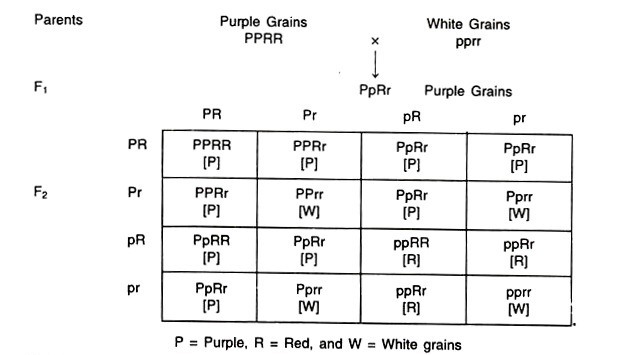
Here allele r is recessive to R, but epistatic to alleles P and p. In F2, all plants with R-P-(9/16) will have purple grains and those with R-pp genotypes (3/16) have red grain colour. The epistatic allele r in homozygous condition will produce plants with white grains from rrP-(3/16) and rrpp (1/16) genotypes.
Thus the normal segregation ratio of 9: 3: 3: 1 is modified to 9: 3: 4 in F2 generation.
Type-2, Dominant Epistasis [12: 3: 1 Ratio]
When a dominant allele at one locus masks the expression of both alleles (dominant and recessive) at another locus, it is known as dominant epistasis. This is also called simple epistasis.
Example- Fruit colour in summer squash.
There are three types of fruit colours in this cucumber, viz., white, yellow and green. White colour is controlled by dominant gene W and yellow colour by dominant gene G. White is dominant over both yellow and green.
The green fruits are produced in recessive condition (wwgg). A cross between plants having white and yellow fruits produced F1 with white fruits. Inter-mating of F1 plants produced plants with white, yellow and green coloured fruits in F2 in 12: 3: 1 ratio.
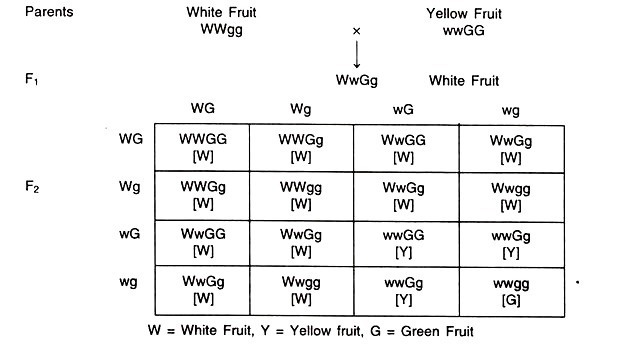
Here W is dominant to w and epistatic to alleles G and g. Hence it will mask the expression of G/g alleles. Hence in F2, plants with W-G-(9/16) and W-gg (3/16) genotypes will produce white fruits; plants with wwG-(3/16) will produce yellow fruits and those with wwgg (1/16) genotype will produce green fruits.
Here, normal dihybrid ratio 9: 3: 3: 1 is modified to 12:3: 1 ratio in F2 generation.
Type-3, Dominant (Inhibitory) Epistasis [13: 3 Ratios]
Here a dominant allele at one locus can mask the expression of both (dominant and recessive) alleles at second locus. This is also known as inhibitory gene interaction.
Example- Anthocyanin pigmentation in rice.
The green colour of plants is governed by the gene I which is dominant over purple colour. The purple colour is controlled by a dominant gene P. The cross between green (IIpp) and purple (iiPP) colour plants, produces F1 with green colour. Inter-mating of F1 plants produced green and purple plants in 13: 3 ratios in F2.
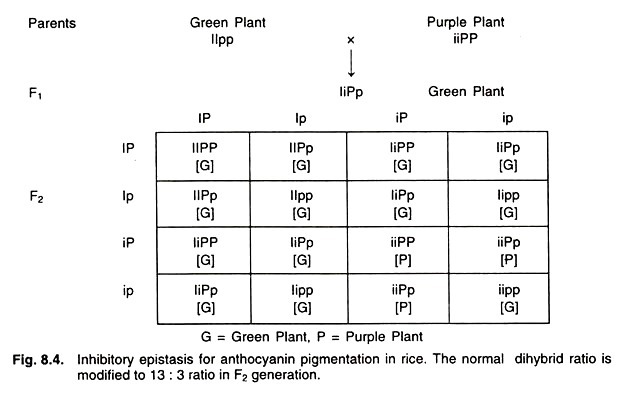
Here, the allele I is epistatic to alleles P and p. Hence in F2, plants with I-P-(9/16), I-pp (3/16) and iipp (1/16) genotypes will be green because I will mask the effect of P or p. Plants with iiP-(3/16) will be purple, because I is absent.
Thus the normal dihybrid segregation ratio 9: 3: 3: 1 is modified to 13: 3 ratios.
Type-4, Duplicate Recessive Epistasis [9: 7 Ratio]
When recessive alleles at either of the two loci can mask the expression of dominant alleles at the two loci, it is called duplicate recessive epistasis. This is also known as complementary epistasis.
Example– Flower colour in sweet pea.
The purple colour of flower in sweet pea is governed by two dominant genes A and B. When these genes are in separate individuals (AAbb or aaBB) or recessive (aabb) they produce white flower.
A cross between purple flower (AABB) and white flower (aabb) strains produced purple colour in F1. Inter-mating of F1 plants produced purple and white flower plants in 9: 7 ratios in F2 generation.
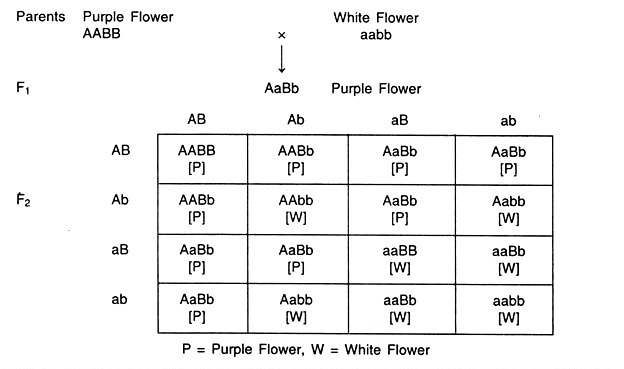
Here recessive allele a is epistatic to B/b alleles and mask the expression of these alleles. Another recessive allele b is epistatic to A/a alleles and masks their expression.
Hence in F2, plants with A-B-(9/16) genotypes will have purple flowers, and plants with aaB-(3/16), A-bb-(3/16) and aabb (1/16) genotypes produce white flowers. Thus only two phenotypic classes, viz., purple and white are produced and the normal dihybrid segregation ratio 9: 3: 3: 1 is changed to 9: 7 ratios in F2 generation.
Type-5, Duplicate Dominant Epistasis [15: 1 Ratio]
When a dominant allele at either of two loci can mask the expression of recessive alleles at the two loci, it is known as duplicate dominant epistasis. This is also called duplicate gene action.
Example- Awn character in rice.
Development of awn in rice is controlled by two dominant duplicate genes (A and B). Presence of any of these two alleles can produce awn. The awnless condition develops only when both these genes are in homozygous recessive state (aabb). A cross between awned and awnless strains produced awned plants in F1. Inter-mating of F1 plants produced awned and awnless plants in 15: 1 ratio in F2 generation.
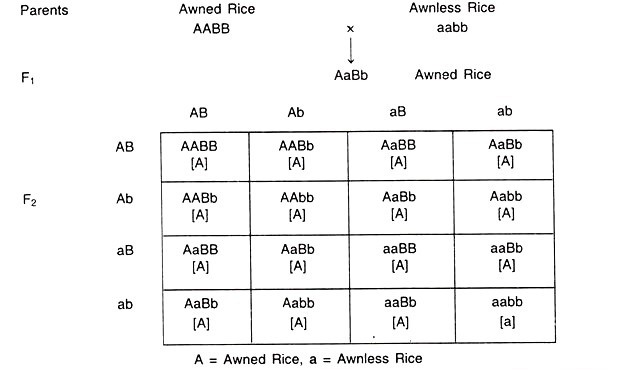
The allele A is epistatic to B/b alleles and all plants having allele A will develop awn. Another dominant allele B is epistatic to alleles A/a. Individuals with this allele also will develop awn character. Hence in F2, plants with A-B-(9/16), A-bb-(3/16) and aaB-(3/16) genotypes will develop awn.
The awnless condition will develop only in double recessive (aabb) genotype (1/16). So, two classes of plants are developed and the normal dihybrid segregation ratio 9: 3: 3: 1 is modified to 15: 1 ratio in F2.
Type, 6, Polymeric Gene Interaction [9:6:1 Ratio]
Two dominant alleles have similar effect when they are separate, but produce enhanced effect when they come together. Such gene interaction is known as polymeric gene interaction. The joint effect of two alleles appears to be additive or cumulative, but each of the two genes shows complete dominance, hence they cannot be considered as additive genes. In case of additive effect, genes show lack of dominance.
Example- Fruit shape in summer squash.
There are three types of fruit shape in this plant, viz., disc, spherical and long. The disc shape is controlled by two dominant genes (A and B), the spherical shape is produced by either dominant allele (A or B) and long shaped fruits develop in double recessive (aabb) plants.
A cross between disc shape (AABB) and long shape (aabb) strains produced disc shape fruits in F1. Inter-mating of F1 plants produced plants with disc, spherical and long shape fruits in 9: 6: 1 ratio in F2.
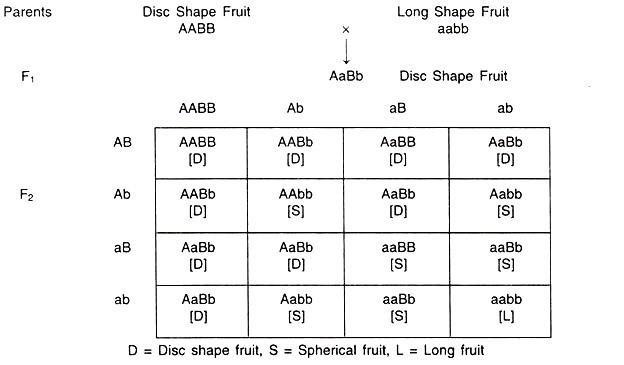
Here plants with A-B-(9/16) genotypes produce disc shape fruits, those with A-bb-(3/16) and aaB-(3/16) genotypes produce spherical fruits, and plants with aabb (1/16) genotype produce long fruits. Thus in F2, normal dihybrid segregation ratio 9:3:3: 1 is modified to 9: 6: 1 ratio.
(Courtesy- Examples are taken from biologydiscussion.comm)
Modifying genes
Modifying genes enhances or reduce the phenotypic effect of a major gene. Such genes have small and cumulative effect on the expression of the major genes. Consequently, continuous variation is generated in the phenotype governed by a single major gene, which converts qualitative character into a quantitative one.
Frequently Asked Question (FAQ)
What is Epistasis?
It is a phenomenon where the expression of one gene is affected by the expression of one or more independently inherited genes.
The term epistasis was coined by?
Bateson in 1909.
What is the difference between Epistatic gene and Hypostatic gene?
The gene that has masking effect is called epistatic gene, and the gene whose effect is masked is known as hypostatic gene.
Read also…
MULTIPLE ALLELES- FEATURES & EXAMPLE
PLEIOTROPY- MEANING, CLASSES & EVOLUTION
TYPES OF CHROMOSOME-STRUCTURE&DEFINITION
LINKAGE AND CROSSING OVER-AN OVERVIEW